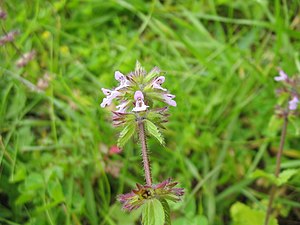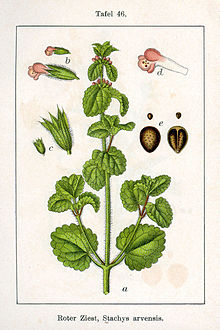Acker-Ziest
| Acker-Ziest | ||||||||||||
|---|---|---|---|---|---|---|---|---|---|---|---|---|

Acker-Ziest on São Jorge , Azores |
||||||||||||
| Systematics | ||||||||||||
|
||||||||||||
| Scientific name | ||||||||||||
| Stachys arvensis | ||||||||||||
| ( L. ) L. |
The Stachys arvensis ( Stachys arvensis ) is a plant of the genus Stachys ( Stachys ) in the family Labiatae (Lamiaceae).
description
Vegetative characteristics
The Acker-Ziest grows as an annual , herbaceous plant and reaches stature heights of usually 30 to 40 (10 to 50) centimeters. The slender stem is prostrate, more rarely upright, sparsely richly branched and often purple and sparsely hairy. The internodes are 1 to 8 inches long.
The leaves are arranged opposite one another on the stem. The lower leaves are stalked 0.5 to 2 centimeters long and the upper ones are sessile. The simple leaf blade is 1 to 3 centimeters long and 0.8 to 3 centimeters wide, broadly ovate to broadly elliptical with a heart-shaped blade base, blunt end and bluntly notched leaf edge. The reticulate leaf blade and densely downy hairy on top and sparsely downy hairy on the underside.
Generative characteristics
The total inflorescence includes about six to twelve widely spaced pseudo whorls with four to six flowers each. In this area, the sessile leaves are shorter than the sepals with a wedge-shaped base and a more or less smooth edge. The bracts are about 1 millimeter long. The short flower stalks are about 1 millimeter long.
The hermaphroditic, zygomorphic , five-fold flowers are 6 to 9 millimeters long with a double flower envelope . Five sepals about 3 millimeters long are fused together like a bell. The ten-nerved calyx, which is densely spaced and hairy, especially on the upper side, is 6 to 7 millimeters long at flowering time and 7 to 8 millimeters long and urn-shaped at fruiting time. The almost identical calyx teeth are about as long as the calyx tube and are lanceolate at flowering time, but almost as wide as long with a pointed end at fruiting time. With a length of 6 to 8 millimeters, the two-lipped corolla is shorter or barely longer than the calyx. The five white, pale pink or red petals are fused. The straight corolla tube has a hair ring inside. The straight upper lip is egg-shaped with a length of 1.5 to 2.5 millimeters and hairy on the outside. The 2 to 3 millimeter long spread lower lip is also stretched out straight and hairy on the outside, three-lobed with rounded or notched middle lobes and smaller, egg-shaped side lobes. The anthers are purple, they lie under the upper lip.
The Klausenfrucht breaks down into four partial fruits, these Klausen are about 1.5 millimeters long, egg-shaped, finely warty-rough and black-brown in color.
The flowering time is mainly in the months from June to November.
The number of chromosomes is 2n = 10 or 18.
Occurrence
The main spread of the Acker-Ziest is the Atlantic Europe . Eastward it occurs to Sweden and Poland , Fujian , Guangdong , Guangxi and Taiwan as well as Russia ; it is rarer in the Mediterranean , but it occurs in the Azores , the Canaries , Madeira and in North Africa to Greece and Crete . In addition, it can also appear abducted. Its occurrences in the Atlantic North America to Brazil are probably later naturalizations.
The Acker-Ziest grows on sandy soils or low-lime loam soils in mild winter climates on moist fields or in gardens. He avoids limestone soils. He is a Kennart of Setario-Stachyetum arvensis, a weed Society (Polygono-Chenopodienion). However, as a result of the intensification of agriculture, it has become rare.
Systematics
This species was first published by Carl von Linné under the name Glecoma arvensis ; In the second edition of his work Species Plantarum in 1763 he placed this species in the genus Stachys .
literature
- Erich Oberdorfer : Plant-sociological excursion flora for Germany and neighboring areas . With the collaboration of Angelika Schwabe and Theo Müller. 8th, heavily revised and expanded edition. Eugen Ulmer, Stuttgart (Hohenheim) 2001, ISBN 3-8001-3131-5 .
- Gustav Hegi: Illustrated flora of Central Europe. Pteridophyta, Spermatophyta . 2nd Edition. Volume V. Part 4: Angiospermae: Dicotyledones 3 (4) (Labiatae - Solanaceae) . Carl Hanser or Paul Parey, Munich or Berlin / Hamburg 1964, ISBN 3-489-78021-3 (unchanged reprint from 1927 with addendum).
- PW Ball: Stachys. In: TG Tutin, VH Heywood, NA Burges, DM Moore, DH Valentine, SM Walters, DA Webb (eds.): Flora Europaea . Volume 3: Diapensiaceae to Myoporaceae . Cambridge University Press, Cambridge 1972, ISBN 0-521-08489-X , pp. 157 (English, limited preview in Google Book search).
- Xi-wen Lin Ian C. Hedge: Lamiaceae. In Wu Zheng-yi, Peter H. Raven (Ed.): Flora of China . tape 17 : Verbenaceae through Solanaceae . Science Press / Missouri Botanical Garden Press, Beijing / St. Louis 1994, ISBN 0-915279-24-X , pp. 184 (English). , Stachys arvensis online. (Section Description and Occurrence)
Individual evidence
- ↑ Rafaël Govaerts (ed.): Stachys arvensis. In: World Checklist of Selected Plant Families (WCSP) - The Board of Trustees of the Royal Botanic Gardens, Kew . Retrieved April 22, 2020.
- ^ Glecoma arvensis L. , Herbarium evidence of the Department of Phanerogamic Botany Swedish Museum of Natural History.
- ↑ Carl von Linné: Species Plantarum , Editio Secunda, 2, 1763, p. 814 scanned at biodiversitylibrary.org. .
Web links
- Stachys arvensis L., Acker-Ziest. In: FloraWeb.de.
- Acker-Ziest . In: BiolFlor, the database of biological-ecological characteristics of the flora of Germany.
- Stachys arvensis (L.) L. In: Info Flora , the national data and information center for Swiss flora . Retrieved February 19, 2016.
- Distribution in the northern hemisphere
- Thomas Meyer: Ziest data sheet with identification key and photos at Flora-de: Flora von Deutschland (old name of the website: Flowers in Swabia ).


